Oxygen plasma modified separator for lithium sulfur battery
Abstract
To reduce the shuttle effect of lithium sulfur (Li–S) batteries and improve the cycling stability, the surface of the commercial separator in an Li–S battery was modified by the O2 plasma treatment, which generated lots of electronegative oxygenic functional groups such as –COOH and –OH on the surface of the separator. In order to confirm the existence and the effect of the electronegative oxygenic functional groups on the modified separator, the contact angle measurement and Fourier Transform Infrared Spectrometry (FTIR) were investigated. The charge/discharge and electrochemical impedance spectroscopy (EIS) tests of the Li–S battery assembled with the normal and the O2 plasma treated separator were analyzed. The surface characterization demonstrated that the oxygenic functional groups on the surface of the separator by the plasma modification played a critical role in improving the wettability and increasing electrical insulating properties. The cycling performance of Li–S batteries with the plasma treated separator had an obvious improvement owing to the electrostatic repulsion between electronegative oxygenic functional groups on the surface of O2 plasma treated separator and electronegative polysulfide. The battery assembled with O2 plasma treated separator had a higher capacity retention (48.53%) than that of the normal separator (24.51%).


 Please wait while we load your content...
Please wait while we load your content...